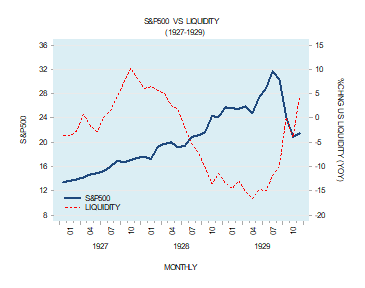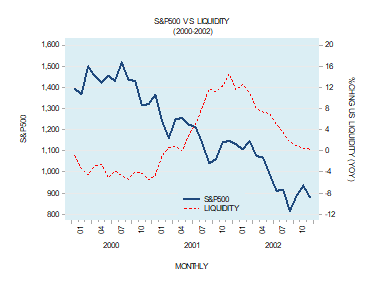In a market economy, a major service that money provides is that of the medium of exchange. Producers exchange their goods for money and then exchange money for other goods. As production of goods and services increases, this results in a greater demand for the services of the medium of exchange (the service that money provides). Conversely, as economic activity slows down the demand for the services of money follows suit.
The demand for the services of the medium of exchange is also affected by changes in prices. An increase in the prices of goods and services leads to an increase in the demand for the medium of exchange.
People now demand more money to facilitate more expensive goods and services. A fall in the prices of goods and services results in a decline in the demand for the medium of exchange.
Now, take the example where an increase in the supply of money for a given state of economic activity has taken place. Since there was not any change in the demand for the services of the medium of exchange this means that people now have a surplus of money or an increase in monetary liquidity.
Obviously, no individual wants to hold more money than is required. An individual can get rid of surplus cash by exchanging the money for goods. Individuals as a group however cannot get rid of the surplus of money just like that. They can only shift money from one individual to another individual.
The mechanism that generates the elimination of the surplus of cash is the increase in the prices of goods. Once individuals start to employ the surplus cash in acquiring goods this pushes prices higher.
As a result, the demand for the services of money increases. All this in turn works towards the elimination of the monetary surplus.
Once money enters a particular market, this means that more money is now paid for a product in that market. Alternatively, we can say that the price of a good in this market has now gone up. (Note that a price is the number of dollars per unit of something).
Observe that what has triggered increases in the prices of goods in various markets is the increase in the monetary surplus or monetary liquidity in response to the increase in the money supply.
Whilst increases in the money supply result in a monetary surplus, a fall in the money supply for a given level of economic activity leads to a monetary deficit.
Individuals still demand the same amount of the services from the medium of exchange. To accommodate this they will start selling goods, thus pushing their prices down.
At lower prices, the demand for the services of the medium of exchange declines and this in turn works towards the elimination of the monetary deficit.
A change in liquidity, or the monetary surplus, can also take place in response to changes in economic activity and changes in prices.
For instance, an increase in liquidity can emerge for a given stock of money and a decline in economic activity.
A fall in economic activity results in fewer goods produced. This means that less goods are going to be exchanged – implying a decline in the demand for the services of money – the services of the medium of exchange.
Once a surplus of money emerges it produces exactly the same outcome with respect to the prices of goods and services as the increase in money supply does i.e. pushes prices higher.
An increase in prices in turn works towards the elimination of the surplus of money – the elimination of monetary liquidity. Conversely, an increase in economic activity whilst the stock of money stays unchanged produces a monetary deficit. This in turn sets in motion the selling of goods thereby depressing their prices. The fall in prices in turn works towards the elimination of the monetary deficit.
There is a time lag between changes in liquidity i.e. a monetary surplus, and changes in asset prices such as the prices of stocks.
(The reason for the lag is because when money is injected it does not affect all individuals and hence all markets instantly. There are earlier and later recipients of money).
For instance, there could be a long time lag between the peak in liquidity and the peak in the stock market. This means that the effect of the previously rising liquidity can continue to overshadow the effect of currently declining liquidity for some period. Hence, the peak in the stock market emerges once declining liquidity starts to dominate the scene.
Exploring how changes in liquidity have historically driven the stock market
The yearly growth rate of liquidity topped in November 1927 at 10.2% – after a time lag of 22 months the S&P500 responded by peaking in August 1929 at 31.71. (Note liquidity is the yearly % changes in AMS minus yearly %changes in the CPI and industrial production). In 1987, the time lag between a peak in liquidity and a peak in the stock market was much shorter – the yearly growth rate of liquidity topped in January 1987 at 15.1%. The S&P500 responded to this by peaking eight months later at 329.9 by August of that year.
|
|
|
According to historical data, the yearly growth rate of liquidity bottomed at minus 16.6% in May 1929. Yet it took a long time before the S&P500 responded to this. It took over three years after the bottom in liquidity was reached before the S&P500 started to recover. The stock price index bottomed in June 1932 at 4.43.
The time lag between the bottom in liquidity and the bottom in the stock market has been however shorter in recent history. The yearly growth rate of liquidity had bottomed at minus 5.4% in September 2000. It took twenty-five months before the S&P500 bottomed at 815.28 by September 2002.
|
|
|
In May 1975 the yearly growth rate of our monetary measure, AMS stood at 4.5%. The yearly growth rate of the consumer price index stood at 9.5% while the yearly growth rate of industrial production closed at minus 12.4%. As a result, our measure of liquidity stood at 7.4%. In response to this, the S&P500 peaked at 107.5 by December 1976. Now, our measure of liquidity hit bottom at minus 10.5% in May 1976. In response to this, the S&P500 reached its bottom at 87.04 in February 1978 – a fall of 19% from the peak.
|
|
|
The S&P500 closed at 1,549.38 in October 2007 before a large decline took place bringing the stock index to 735.1 by February 2009 – a fall of 52.3%. The yearly growth rate of liquidity peaked at 6.1% by June 2003 (see chart). The bottom in the stock price index at 735.1 reached by February 2009 well after a bottom in liquidity at minus 5.9% took place in November 2007.
|
|
|
Where is the S&P500 heading?
Our measure of liquidity has peaked at 16.3% in October 2016. Thereafter it fell to minus 4.5% by November 2017. This we suggest poses a threat to the S&P500. It is quite likely that the stock price index has peaked in September 2018 at 2,914.
|
|











